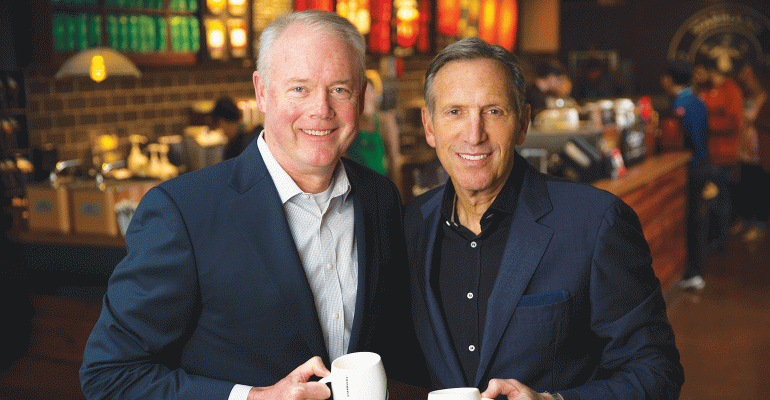Starbucks Corp. chairman and CEO Howard Schultz is relinquishing the helm of the coffeehouse chain’s global operations in April, but he’s by no means going away.
Kevin Johnson, the Seattle-based company’s president and chief operating officer, will become CEO in the spring.
Schultz will take the role of executive chairman, and will turn his focus to growing Starbucks’ ultra-premium brands.
The C-suite shakeup comes as Starbucks sets an aggressive five-year agenda, planning for an additional 12,000 units globally, to reach 37,000 locations by 2021.
The core brand continues to build on its position as a digital leader to capture the consumer move away from brick-and-mortar retail.
As Starbucks CEO, Johnson will bring his technology background as former CEO of Juniper Networks Inc. and a former Microsoft executive to the role.
Johnson pledged to lead the company his own way, and not in Schultz’s shadow. “I realize I’m not Howard. I’m Kevin. I’m going to lead in an authentic way,” he told CNN.
Schultz said Johnson is more equipped to be CEO of the 25,000-unit chain as Starbucks grows its digital prowess around the world. The incoming CEO has also been a Starbucks board member since 2009, and Johnson and Schultz have been working together for years to get to this point.
The change is unlike Schultz’s previous departure from the CEO role. In 2000, he stepped back to become chief global strategist, as well as owner of the Seattle Supersonics basketball team, only to return as Starbucks CEO eight years later.
This time, Schultz is returning to his entrepreneurial roots, growing the new Roastery format, as well as the modified Reserve coffeehouse variation, offering a more-premium experience.
The chain sees super-premium brands as destinations that have the potential for significantly higher returns.
Starbucks Reserve stores, for example, will serve micro-lot coffees made with the latest brewing methods and food from the recently acquired Italian bakery Princi, as well as alcohol. Starbucks estimates that the units will deliver twice the unit economics of a typical Starbucks, and more than 1,000 are planned, with the rollout beginning in 2017. Reserve specialty coffees will be available in about 20 percent of traditional Starbucks locations by 2021.
The original Roastery location in Seattle, offering a fully immersive coffee experience, recorded a 24-percent increase in same-store sales in fiscal 2016. Additional units are scheduled for Shanghai, New York and Tokyo in the next two years.
Schultz envisions 20 to 30 Roastery outlets around the world, serving as innovation labs for the rest of the chain and casting a better-coffee halo over the brand overall.
Long proven as a visionary who taught the masses to pay more for better coffee, Schultz’s next step toward premiumization could be the key to Starbucks’ long-term future.
But he won’t be able to do it without Johnson keeping the Starbucks mothership afloat and healthy.
Contact Lisa Jennings at [email protected]
Follow her on Twitter: @livetodineout






